
Ely is a city in St. Louis County, Minnesota, United States. The population was 3,268 at the 2020 census.

Tower station, often called the Tower Passenger Depot, is a former passenger railroad depot in Tower, Minnesota, United States, that is listed on the National Register of Historic Places. Built in 1916 by the Duluth and Iron Range Railroad, it provided passenger train service until 1951. It currently operates as the Tower-Soudan Historical Society Center museum.

Hill-Annex Mine State Park is a former state park of Minnesota, United States, interpreting the open-pit mining heritage of the Mesabi Range. The park was located north of the city of Calumet, in Itasca County, Minnesota. The park provided access to fossil material exposed by mining from the Cretaceous era Coleraine Formation.

The Hennepin Center for the Arts (HCA) is an art center in Minneapolis, Minnesota, United States. It occupies a building on Hennepin Avenue constructed in 1888 as a Masonic Temple. The building was designed by Long and Kees in the Richardsonian Romanesque architectural style. In 1978, it was purchased and underwent a renovation to become the HCA. Currently it is owned by Artspace Projects, Inc, and is home to more than 17 performing and visual art companies who reside on the building's eight floors. The eighth floor contains the Illusion Theater, which hosts many shows put on by companies in the building.

The Lake Vermilion-Soudan Underground Mine State Park is a Minnesota state park at the site of the Soudan Underground Mine, on the south shore of Lake Vermilion, in the Vermilion Range (Minnesota). The mine is known as Minnesota's oldest, deepest, and richest iron mine. It formerly hosted the Soudan Underground Laboratory. As the Soudan Iron Mine, it has been designated a U.S. National Historic Landmark.
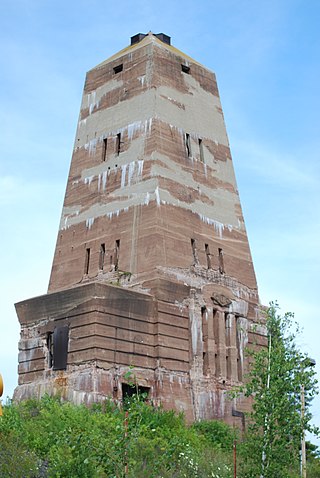
The Cliffs Shaft Mine Museum is a former iron mine, now a heritage museum, located on Euclid Street between Lakeshore Drive and Spruce Street in Ishpeming, Michigan. The museum, operated by "Marquette Range Iron Mining Heritage Theme Park Inc.", celebrates the history of the Marquette Iron Range. The site was designated a state of Michigan historic site in 1973 and placed on the National Register of Historic Places in 1992.

The Hull–Rust–Mahoning Open Pit Iron Mine in Hibbing, Minnesota, United States, is the largest operating open-pit iron mine in Minnesota. The pit stretches more than three miles (5 km) long, two miles (3 km) wide, and 535 feet (163 m) deep. It was established in 1895 and was one of the world's first mechanized open-pit mines.

Crosby station is a historic former train station in Crosby, Minnesota, United States. It was established in 1910. It was listed on the National Register of Historic Places in 1980 as the Crosby Railroad Depot for having local significance in the themes of commerce, industry, and transportation. The depot was nominated for being an essential conduit for the arrival of goods and people and the export of iron ore during central Crow Wing County's economic boom years.
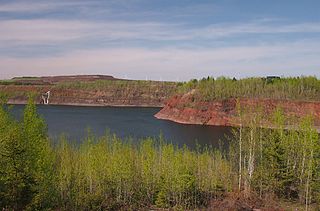
Mountain Iron Mine is a former mine in Mountain Iron, Minnesota, United States. Opened in 1892, it was the first mine on the Mesabi Range, which has proved to be the largest iron ore deposit ever discovered in the United States. Mining operations at the site ceased in 1956. The bottom of the open-pit mine has filled with water but its dimensions are readily visible. The city maintains an overlook in Mountain Iron Locomotive Park.

The St. Louis County Depot is a historic railroad station in Duluth, Minnesota, United States. It was built as a union station in 1892, serving seven railroads at its peak. Rail service ceased in 1969 and the building was threatened with demolition until it reopened in 1973 as St. Louis County Heritage & Arts Center . Train service also resumed from 1974 to 1985, by Amtrak.

This is a list of the National Register of Historic Places listings in Saint Louis County, Minnesota. It is intended to be a complete list of the properties and districts on the National Register of Historic Places in Saint Louis County, Minnesota, United States. The locations of National Register properties and districts for which the latitude and longitude coordinates are included below, may be seen in an online map.

This is a list of the National Register of Historic Places listings in Crow Wing County, Minnesota. It is intended to be a complete list of the properties and districts on the National Register of Historic Places in Crow Wing County, Minnesota, United States. The locations of National Register properties and districts for which the latitude and longitude coordinates are included below, may be seen in an online map.

This is a list of the National Register of Historic Places listings in Rock County, Minnesota. It is intended to be a complete list of the properties and districts on the National Register of Historic Places in Rock County, Minnesota, United States. The locations of National Register properties and districts for which the latitude and longitude coordinates are included below, may be seen in an online map.
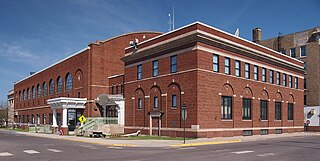
The Virginia Recreation Building is a former community center in Virginia, Minnesota, United States, that was later converted into a factory. It was designed by architect Frederick German and built in 1923 as an ice hockey and curling rink to provide a public venue for physical development to the working class men largely employed in Iron Range mines. A generation later, as the gender balance of the city's population evened out, the building was converted into a shirt factory in 1947 to create jobs for women. The building was listed on the National Register of Historic Places in 1982 for its state-level significance in the themes of industry and social history. It was nominated for encapsulating the social welfare of the Progressive Era and the robust public spending funded by the mining boom, and the transition to a more gender-balanced population and need to diversify the economy.
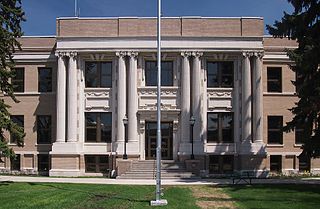
The St. Louis County District Courthouse is the seat of government for the northern district of St. Louis County, Minnesota, United States, located in the city of Virginia. The St. Louis County District Court is held in three locations: Duluth, Hibbing and Virginia.

The Stuntz Bay Boathouse Historic District comprises a row of 143 boathouses on Lake Vermilion in Breitung Township, Minnesota, United States. They were mostly built in the first half of the 20th century by employees of the adjacent Soudan Iron Mine. The mining company provided the lots to employees as a reward for their years of service, and the miners did their own construction. Most of the boathouses were built with tamarack logs and scrap corrugated metal from the mine property. Boating and fishing were major pastimes for the mine employees and their families in their leisure hours, and the mining company promoted access to outdoor recreation as a perk of employment. The Stuntz Bay Boathouses were listed as a historic district on the National Register of Historic Places in 2007 for their local significance in the themes of architecture, entertainment/recreation, industry, and social history. They were nominated for illustrating the personal lives of the miners and vernacular metal architecture.
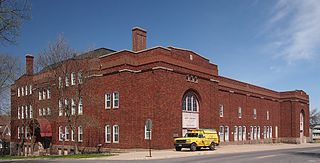
The Eveleth Recreation Building, later the Arrow Shirt Factory, is a historic building in Eveleth, Minnesota, United States. It was constructed in 1918 as a municipal gymnasium, with a curling rink on the ground floor and an ice hockey rink on the second floor. At that time the city of Eveleth was flush with tax revenue from the Mesabi Range mining boom, and the population was heavily male from the influx of mine workers. As the gender balance evened out in the 1930s, the building was converted into a garment factory, answering a need for employment opportunities for women and diversifying the local economy.
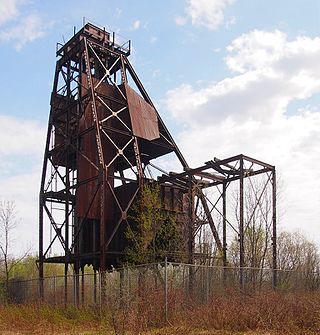
The Bruce Mine Headframe is the headframe of a former underground mine in Chisholm, Minnesota, United States. It was built 1925–26 and operated until the mine closed in the early 1940s. The Bruce Mine Headframe was listed on the National Register of Historic Places in 1978 for its state-level significance in the theme of engineering. It was nominated for being the last standing example of the headframes that once proliferated on the Mesabi Range. Most of the other headframes were dismantled as open-pit mining overtook underground mining as the dominant extraction method in the region.
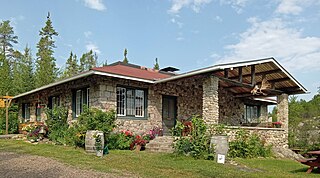
Chik Wauk Lodge, now Chik-Wauk Museum and Nature Center, is a historic building near the northern terminus of the Gunflint Trail northwest of Grand Marais, Minnesota, United States. It overlooks Saganaga Lake.























